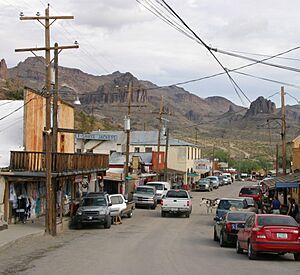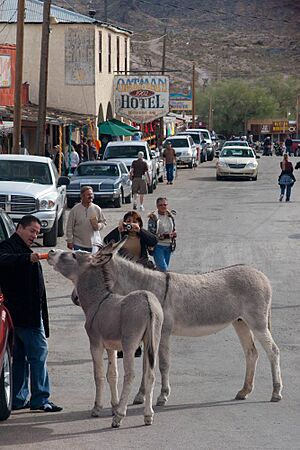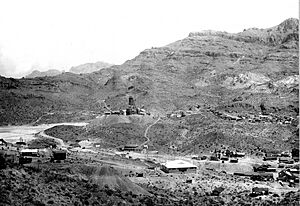Oatman, Arizona facts for kids
Quick facts for kids
Oatman, Arizona
|
|
|---|---|

Main street of Oatman, August 2005
|
|
| Country | United States |
| State | Arizona |
| County | Mohave |
| Named for | Olive Oatman |
| Area | |
| • Total | 0.19 sq mi (0.50 km2) |
| • Land | 0.19 sq mi (0.50 km2) |
| • Water | 0.00 sq mi (0.00 km2) |
| Elevation | 2,710 ft (826 m) |
| Population
(2020)
|
|
| • Total | 102 |
| • Density | 531.25/sq mi (205.08/km2) |
| Time zone | UTC-7 (MST (no DST)) |
| ZIP Code |
86433
|
| FIPS code | 04-50620 |
Oatman is a small town located in the Black Mountains of Arizona, United States. It sits high up, about 2,710 feet (826 meters) above sea level.
In 1915, Oatman started as a mining camp when two gold prospectors found a lot of gold. The area had already been settled for some years. In just one year, Oatman's population grew to over 3,500 people. Today, it is much smaller, with about 102 residents as of 2020.
The town is now a popular Wild West tourist spot. It is famous for the wild burros (donkeys) that freely walk around the streets.
Contents
The Story of Oatman: A Wild West Town
The town of Oatman was named after Olive Oatman. She was a young girl from Illinois whose family was attacked in 1851 while traveling west. Olive was captured and enslaved by Native Americans. She was later traded to the Mohave people, who adopted her. The Mohave people tattooed her face, which was a custom of their tribe. Olive was finally released in 1856.
Gold Discovery and Mining Boom
In 1863, a prospector named John Thomas Moss found gold in the Black Mountains. He claimed several mining spots, naming one "Moss" after himself and another after Olive Oatman. For the next 50 years, gold mining in the area went up and down.
In the early 1900s, new technology and lower transportation costs helped Oatman grow. New gold discoveries also brought more people and money to the town. In 1915, the Tom Reed mine opened. Then, a rich gold deposit was found nearby at the United Eastern Mining Company. This started one of the last big gold rushes in the desert.
From 1915 to 1917, Oatman became a busy boomtown. It had all the excitement and characters of a gold rush town. For about ten years, the mines in Oatman were among the biggest gold producers in the American West.
Oatman Hotel and Later Years
In 1921, a fire destroyed many of Oatman's smaller buildings. However, the Oatman Hotel, built in 1902, was saved. It is still the oldest two-story adobe building in Mohave County. It is also a historical landmark.
One popular story about the hotel is that actors Clark Gable and Carole Lombard spent their honeymoon there in 1939. However, they actually went straight to Los Angeles after their wedding. They had their honeymoon later in Baja California.
In 1924, the town's main employer, United Eastern Mines, closed down. They had produced a lot of gold, but the government controlled its price. By 1941, all gold mining in Oatman was stopped. This happened because of World War II. Other metals were needed for the war effort.
Oatman was lucky because it was located on the busy U.S. Route 66. Travelers driving between Kingman, Arizona, and Needles, California, would stop there. But this advantage did not last long. In 1953, a new road was built that bypassed Oatman completely. By the 1960s, Oatman was almost empty.
Oatman Today: A Tourist Destination
Today, Oatman survives as a fun stop along historic Route 66. It has a real Wild West feel with wooden sidewalks and pretend shootouts. The town is most famous for its wild burros. These friendly donkeys wander the streets freely. The government usually rounds up wild burros in other areas. But they let the burros stay in Oatman because they are a big part of the town's charm.
See also
 In Spanish: Oatman (Arizona) para niños
In Spanish: Oatman (Arizona) para niños





